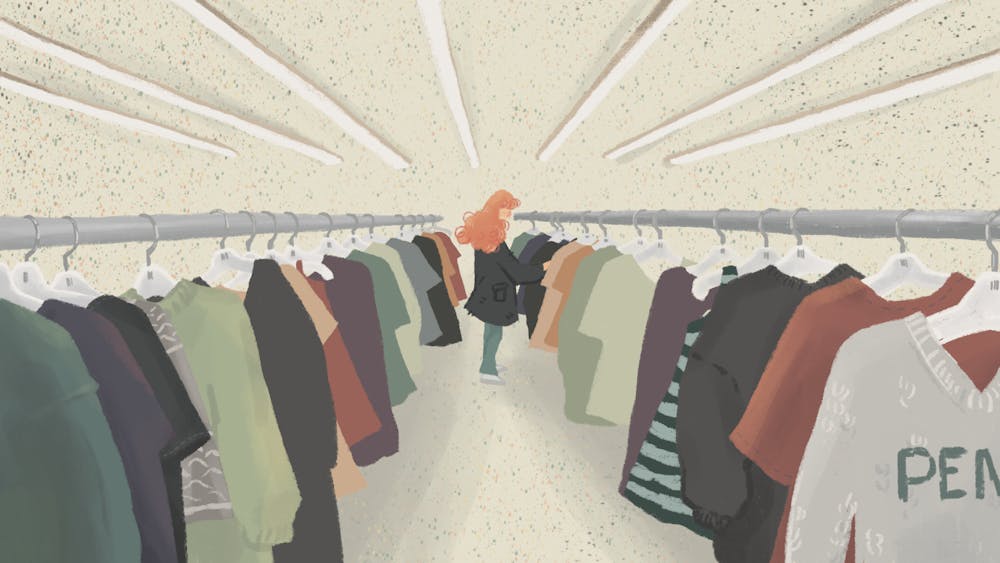Under Bangkok’s scorching sun, the thick air blanketed the disordered piles of unwanted clothes. As I dug through Chatuchak Market’s endless textiles, I scooped up a stained Polo Ralph Lauren shirt of questionable authenticity, merch from an unheard–of university in the Midwest, and a pair of cargos nice enough to try on. In one of the largest thrift markets in Bangkok, a blend of Pinterest–worthy vintage stylers and local moms fitting their kids unite in their search for cheap clothes.
As I wandered to the next stall, the “premium” racks of jackets caught my eye, boasting their hanger–ed status amid the endless piles of loose fabric. At its very front was the one. A red and blue jacket with four big letters on the chest: “PENN.” All the way from Walnut Street, a jacket made it across the globe to a weekend market in Thailand. While its terrible condition invalidated the $30 price tag, the question remained: Why is this here?
The journey of this jacket started at a local thrift store. A Penn grad or a salty Penn reject donates the jacket, and it is sadly left without demand. With nearly 150,000 pounds of clothing donated to just Goodwill per day, it's virtually impossible for a store to clear its inventory. After a while, the leftover stock is transported to one of 142 outlet stores across the country, where clothes are sold by weight from $.49 to $1.29 per pound.
Whatever isn’t sold in outlets is then sold for pennies to businesses such as Used Clothing Exports, the largest exporter of used clothing in the world. The company employs hundreds of mostly immigrant workers as graders, sorting clothes into bales of four different grades. Adam Minter, in his book Secondhand: Travels in the New Global Garage Sale, explains that the workers at this warehouse process over 200,000 pounds of clothing each week. The clothes that make it out are then shipped once more to various countries across the world, with a near–even distribution between Sub-Saharan Africa, Southeast Asia, and Eastern Europe.
Upon docking at their destination, the bales are further sorted by local preference, filtering trash from fashion. As containers are unloaded, what used to be a donation from a family in Nebraska now becomes a product, a commodity just like any other. As Minter further explains, there is a clear distinction between sorting done in the United States and other countries. While a Goodwill in Philadelphia may grade based on the item’s logo, skilled sorters in, say, Thailand don’t need a tag to know its quality. A quick hand–feel sends low quality garments straight to the cheap pile, where someone might buy them at the lowest price.
Depending on their given grades, these clothes are then shipped locally to vintage boutiques, thrift stores, open–air markets, and the landfill. While the Penn varsity jacket may have landed on the upper end of the market, other items in these open markets sell shirts for as little as 20 to 30 U.S. cents.
How does this happen? With countless businesses across the world contributing to the jacket’s journey, the global thrift trade is not one of charity. It's the fact that, even as the varsity jacket with damage and numerous holes treks the world, every step adds just enough value to make the whole process worthwhile (and profitable). The industry has perfected labor, shipping, and sales to the point where this convoluted system has proven its success.
Even so, this global process is not without its issues. Critics argue there is a correlation between high rates of used clothing imports and declines in domestic textile production, with prominent examples seen in Nigeria and Kenya. With used clothes flooding the market at incredibly low prices, little motivates consumers to buy new, domestically produced textiles. This was demonstrated in Senegal in the 1980s and 1990s, when the liberalization of secondhand imports led to a complete collapse of the domestic knitted garments industry. In the years following, Oxfam estimates 3,500 job losses in industrial clothing production, directly harming the local economy. As a result, multiple countries, including Uganda, the Philippines, China, and India have imposed bans on used clothing imports, with the president of Uganda condemning used American clothing as as “clothes from the dead people.” Yet, overpowering economic forces continue to smuggle used clothing into these countries.
When someone out there in Thailand decides to buy that Penn jacket, that is one jacket saved from the landfill, given a second life. But is this process really sustainable? 40% of "recycled" American clothing is unable to be sold and instead ends up in dumpsters worldwide. As countries become richer and richer, preferences for new, trendy clothing also rises. Take China for example, which throws away 26 million tons of clothing annually. As these preferences render thrifting obsolete, more clothing and instead ends up in dumpsters worldwide.
In many countries, the infrastructure required to dispose of massive amounts of textile waste is also absent, resulting in acres of clothes scattered through fields, deserts, and oceans. So perhaps the journey of the Penn varsity jacket isn’t one of sustainability and global cooperation, but rather reflects the United States' deflection of responsibility.

